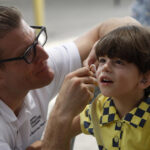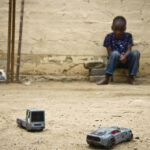Communities are bringing HIV monitoring and dispensing out of the clinics and into their homes.
“Siyanda!” Fanelwa Gwashu’s voice carries over the soft chatter inside the two-bedroom shack in Khayelitsha, a township on the Cape Flats in the City of Cape Town.
She shifts the large register from her arm, resting it on the tiny kitchen counter in front of her.
Siyanda looks up from her seat on the bed in the adjacent room, checks the number Gwashu wrote on her hand in koki pen a few minutes earlier, and answers, “65”.
Gwashu records the figure in the register and asks playfully: “Sho! What have you been eating?”
The other HIV-positive men and women seated around the kitchen and bedroom laugh.
Siyanda, a tall and slender woman, smiles and looks shyly at her socked feet. According to Gwashu’s register she has gained four kilograms since their last meeting.
Community health
Every two months Gwashu, a lay health worker employed by Médicins Sans Frontières, meets these 15 Khayelitsha residents in Siyanda’s shack to weigh them, enquire about any other health problems and dispense a supply of HIV medication to each person to last them until their next meeting.
Gwashu says the patients are happier because they spend a maximum of an hour every two months collecting their medication in Siyanda’s shack instead of a possible seven hours waiting in clinic queues.
“But it also helps sisters at the clinic see more patients and even start more people living with HIV on treatment,” she says.
The health department’s national strategic plan on HIV, tuberculosis and sexually transmitted infections has set a target that 80% of all eligible people should be on HIV treatment by 2016.
To be eligible for treatment, according to the plan introduced in 2012, patients need to have a CD4 count – a measure of a person’s immunity – of 350 or less.
But the eligibility criteria have since changed.
Moving target
In January this year, the health department expanded its programme to provide HIV-infected people with a CD4 count of 500 with treatment. This means a much higher number of patients have become eligible for treatment, placing the 2016 plan target further from the country’s reach.
The health department’s deputy director general for HIV and maternal health, Yogan Pillay, says that, taking the more than three million people on treatment and the new criteria into account, 80% of eligible women, 50% of eligible men and 65% of eligible children are on treatment.
He warns that this is a “moving target” that is likely to change if the World Health Organisation issues different treatment guidelines to include people with CD4 counts higher than 500.
According to a May study published in the Journal of the International Aids Society, 95% of HIV services in South Africa are provided from health facilities. But this needs to decrease by at least 25% if the country is to reach its “ambitious [treatment] targets” and “reduce congestion at busy health facilities”.
The authors concluded that at least 30% of all HIV services in the country need to be provided outside of health facilities, if 80% of eligible patients are to start on treatment by next year.
The antiretroviral (ARV) adherence club chaired by Gwashu is one solution that health organisations suggest will help unburden the health department and enable more people to get treatment, but also to make staying on treatment easier for them.
“Patients who feel healthy and are stable shouldn’t have to sit in three clinic queues every one or two months and waste at least half a day when all they need is to get a new supply of drugs,” says Lynne Wilkinson, project co-ordinator for Médecins Sans Frontières South Africa.

Stable patients
If a patient has an undetectable viral load – when the amount of virus in the blood is so low it will not be picked up on regular HIV tests – it means the ARVs are working well to suppress the HIV, and such a patient can be called “stable”, says Wilkinson.
Only stable patients qualify to be placed in a club near their home because they are less likely to have health complications that require a health professional’s advice.
“These patients generally feel healthy and are largely noninfectious. For them, seeing a clinician at the clinic every month or two is a waste of time,” she adds.
The prescriptions for each patient are sent from the clinic to the central dispensing unit (CDU) every two months before the club meets.
“The drugs are prepacked and sealed at the CDU and then transported back to the clinic where the club facilitator picks them up on her way to the meeting,” she says.
Once a year, all club members are required to go to the clinic and be seen by a nurse who checks their viral load to see whether their condition is still stable.
Meeting clubs
These clubs were initially based at health facilities but have now been expanded to other venues such as churches, crèches and even patients’ homes.
Each club decides on the best time of day for its members to meet, but most take place outside of work hours in the mornings or evenings.
Andile Madondile, who has lived with HIV since 2004, hosted the first home club in his Khayelitsha shack in 2012.
“Those who are working can get to work on time because this only takes 45 minutes so, yes, you save time. But something else I’ve noticed is these clubs are like support groups too,” he says. “We sit and chat here and we are all from this same area – we have even helped group members disclose their HIV status to their families.”
He says that with increasing awareness, more people want the convenience of becoming part of a club – but few new ones are being started in Cape Town.
The adherence club model, which started as a pilot project in Khayelitsha in 2007 and was then adopted by the Western Cape department of health in 2011, has steadily expanded across the metropolitan area. Now, more than 30 000 patients receive their HIV medication through this route. This is equivalent to about 25% of the total cohort – or group of HIV patients – in the Cape metropolitan area.
Lack of funds
Wilkinson estimates that between 50% and 70% of the total cohort is stable and would therefore qualify to be placed in a club, but there are not enough funds to expand the project to its full potential.
“While this model is cost-effective, it isn’t free. By expanding the clubs, we are freeing up space in the clinics, which means more people on treatment. When the total cohort expands, we need more health workers, such as nurses, doctors and pharmacists, as well as lay workers to facilitate clubs, which the department can’t afford to appoint right now,” she says.
According to Médecins Sans Frontières research, 19% of the 23 220 patients receiving ARVs at nine Khayelitsha health facilities were managed through 180 clubs during 2012 – 11% shy of the 30% target set out in the Journal of the International Aids Society study.
Back in Siyanda’s shack, Gwashu continues recording patients’ weight and giving them their supply of HIV medication.
“Nomfundo!” she calls out.
“62,” answers a thin elderly man seated on a white plastic chair in the corner of the small kitchen.
“But what happened, tata. You were 67kg last time?” she asks, sounding both firm and kind.
“I’ve had the flu, sisi,” he responds.
“For how long?” she asks.
There is a risk Nomfundo’s weight loss could mean his medication is no longer working to fight his HIV.
“About a week now,” he explains. “But I’ve got some vitamins from the clinic and I’m feeling better.”
Gwashu, on the lookout for any worrying signs to report to the nurses at the clinic, thinks for a moment before she writes “62” in the register and hands Nomfundo his sealed pack of drugs.
“I’ll be coming to do an extra check on you next week,” she says to the man as he bends to exit the small shack.
He takes a few steps into the morning fog on the way to his job as a labourer before turning to Gwashu with a smile: “I know you will, sisi.”
Amy Green was a health reporter at Bhekisisa from 2013 until 2016.





